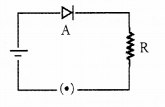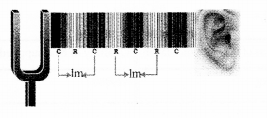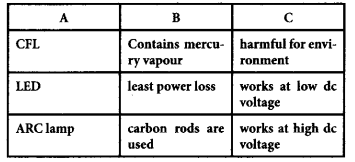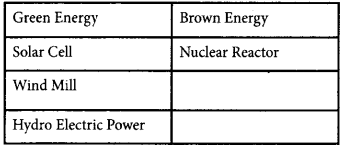Kerala SSLC Physics Previous Question Papers with Answers Paper 3 are part of Kerala SSLC Physics Previous Year Question Papers with Answers. Here we have given Kerala SSLC Physics Previous Question Papers with Answers Paper 3.
| Board | SCERT |
| Class | SSLC Class 10 |
| Subject | Physics |
| Category | Kerala SSLC Previous Question Papers |
Kerala SSLC Physics Previous Year Question Papers with Answers Paper 3 Free Download English Medium
Time Allowed: 1 1/2 hours
Cool off time: 15 Minutes
Maximum Marks: 40
Instructions
- First 15 minutes is cool off time.
- Answer the questions only after reading instructions and questions thoroughly.
- Questions are given in A, B, C, D sections. Write only 4 questions from each section.
- Score allotted for sections A, B, C, D are 1, 2, 3 and 4 respectively.
Questions
SECTION A
Question 1.
Study the relation between the first pair and then complete the second pair.
(i) Resistor :
![]()
(ii) LED : ……….
Question 2.
Which of the following is not a part of an AC generator ?
(i) Field magnet
(ii) Armature
(iii) Transformer
(iv) Slip rings
Question 3.
Find the correct statement from the following.
(i) The main constituent of LPG is carbon dioxide.
(ii) The bio-gas is formed by the action of bacteria in the presence of oxygen.
(iii) The uncontrolled fission is used in atom bomb.
Question 4.
Three statements related to a three phase generator are given below of which one is incorrect. Identify the wrong statement and write it in the correct form.
(i) All the three armature coils have equal number of turns.
(ii) AC generated in all the three armature coils will be in same phase.
(iii) AC of same frequency is generated in all the three armature coils.
Question 5.
A current of 0.2 A flows through a resistor of resistance 200 Ω. Calculate the heat generated by the resistor in 5 minute.
Question 6.
Spirit taken in a watch glass disappears into air even without heating.
(a) Write the name of above phenomenon.
(b) Explain a daily life situation where the above phenomenon is used.
Question 7.
Match the three columns suitably.

Question 8.
Observe carefully the following diagrams which show the splitting up of a composite light into its constituent colours.

(a) Which among the above figures is correct? Give reason.
(b) Write the name of the phenomenon.
Question 9.
Thickness of insulated copper wire used in the primary turns and secondary turns of a transformer are not equal.
(a) In a step up transformer which set of turns (primary/ secondary) is made of thicker copper wire ? Justify your answer.
(b) Write down the working principle of a transformer.
Question 10.
When the stem of an excited tuning fork is pressed on a table, the surface of the table vibrates at the frequency of the tuning fork.
(a) The vibration of the table surface under the influence of a vibrating tuning fork is an example for___vibration
(b) When does the table is said to be in resonance with the tuning fork ?
(c) Write the name of an instrument that is used in laboratory to demonstrate the phenomenon of resonance on a stretched string or wire.
Question 11.
Observe the circuit diagram given below

(a) Identify the electronic component marked A.
(b) In the above circuit diagram the component A is in___biasing.
(c) Draw the voltage-time graph of output (across the resistor R) if the DC voltage source in the above diagram is replaced by an AC voltage source.
Question 12.
Wind mill, Hydro electric power, Nuclear reactor and Solar cell are four energy sources.
(a) Classify the above four energy sources as green energy and brown energy.
(b) What is meant by green energy ?
Question 13.
The following figure illustrates the propagation of sound waves from a tuning fork 341 Hz to our ears

(a) Which type of mechanical wave is shown in the figure ?
(b) Analyse the figure carefully and identify the frequency and wavelength of the wave.Hence calculate the speed of sound wave represented.
Question 14.
Power transmission is the process of sending electricity to distant places through wires from the power station.
(a) Write any two difficulties faced when electrical power is to be transmitted to distant places.
(b) Which type of transformer is used at the power stations as power transformer ?
(c) What is the voltage of electricity supplied for domestic consumption ?
Answers either 15(A) OR 15(B) completely.
Question 15.
(A) The figure given below shows electromagnetic spectrum

(a) Write the name of the wave that lies in between visible light and X-rays in the electromagnetic spectrum.
(b) Give one use each for infrared rays and X-rays.
(B) Three primary colours are incident on a transparent blue glass slab as shown below. One of the incident colours is marked X and the color that passes out of the glass slab is marked Y.

(a) Identify the colours marked X and Y in the given figure.
(b) In what colour does a red apple appear if it is observed in the colour Y which is coming out of the blue glass plate shown above ?
Answer either 16(A) OR 16(B) completely.
Question 16.
(A) The table given below shows the data obtained in an experiment for determining the specific heat capacity of coconut oil.

(a) What is meant by specific heat capacity of a substance ?
(b) Write the answer in SI unit of specific heat capacity.
(c) Calculate the specific heat capacity of coconut oil using data given in the table.
OR
(B) In SI unit Latent heat of fusion of ice is 335 x 10³ units.
(a) What is meant by Latent heat of fusion ?
(b) Write the SI unit of Latent heat of fusion.
(c) Calculate the quantity of heat required to completely convert 5 kg of ice at 0°C into water at the same temperature.
Answers
Answer 1.
![]()
Answer 2.
Transformer
Answer 3.
(iii)
Answer 4.
ii. AC generated in all three armature coils will be of different phases the at same time.
Answer 5.
H = I²Rt, I = 0.2A R = 200Ω
t = 5×60 = 300s
H = (0.2)² × 200 × 300 = 0.04 × 60000 = 2400J
Answer 6.
a. Evaporation
b. Water kept in earthern pots cools well.
Answer 7.

Answer 8.
a. Fig (i)
The colour which has least wavelength deviates most. Violet has least wavelength. So it deviates most
b. Dispersion
Answer 9.
a. Primary- The power in the primary and secondary of transformer are equal. Current is more where voltage is less because P = VI. Thick wires are needed to flow more quantity of current. Hence thick wires are used in the primary of step up transformer.
b. Mutual Induction
Answer 10.
a. Forced vibration
b. The table is said to be in resonance when the frequency of the tuning fork and it’s natural frequency become equal.
c. Sonometer
Answer 11.
a. Diode
b. Forward Biasing
c.

Answer 12.
a.

b. The energy made from sources which are suitable for nature, without causing environmental pollution is called green energy.
Answer 13.
(a) Longitudinal waves
(b) Frequency \(f=\frac { n }{ t }\)
f = 341Hz λ = 1 m
Speed of Sound wave = V = fλ = 341 x 1 = 341m/s
Answer 14.
a. Voltage Drop and Power Loss
b. Step up Transformer
c. 230V
Answer 15.
A.a. Ultraviolet
b. Infrared rays – Makes Sunlight hot
X rays – Penetrates through flesh
B. a. X-green Y -Cyan
b. White colour
Answer 16.
A.a. The heat energy required to raise the temperature of a substance of man 1kg by 1K is the specific heat capacity of that substance.
b. Jkg-1 K-1
c. Q = mcθ

B. a. Latest heat of fusion of a solid is the quantity of heat absorbed by 1kg of the solid to change into its liquid state of its melting point without change in temperature.
b. J/kg
c. Quantity of heat required = 5×335×103 = 1675×103 J
We hope the given Kerala SSLC Physics Model Question Papers with Answers Paper 3 will help you. If you have any query regarding Kerala SSLC Physics Model Question Papers with Answers Paper 3, drop a comment below and we will get back to you at the earliest.
